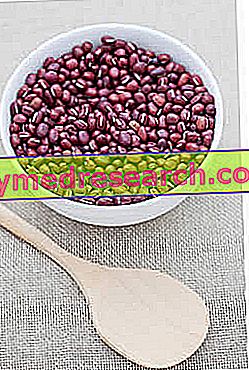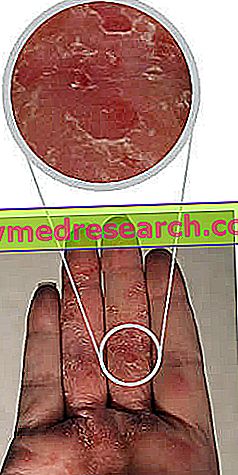What are
Azuki beans (also called aduki or adzuki ) are the seeds of the Vigna angularis plant.
The name "azuki" is a transliteration of the original Japanese word ア ズ キ, but there is also a noun naturalized by the Chinese called "shōzu" (or "small bean", since "big bean" means soy).

The azuki plant is an annual cycle legume native to eastern Asia and the Himalayas, where it was first cultivated by crossing it with other species; the first archaeological finds were brought to light at Ruin Awazu-Kotei (in Japan) and lead back to the middle period Jō mon from 4000 BC
The most common azuki bean plant produces small seeds (about half a centimeter long) of a uniform red color, but there is no lack of black, white, gray and mottled varieties. Botanists speculate that the ancestor of the many varieties of azuki beans is the nipponensis .
Nutritional Features
Azuki beans are edible seeds that provide a fair amount of energy. Calories come essentially from carbohydrates, but proteins (with a medium biological value) are not negligible; triglycerides, on the other hand, are not particularly relevant.
In whole seeds the portion of fibers is more than good, while it is decidedly lower in those peeled and in pasta. Cholesterol is absent, while other beneficial steroid molecules (phytosterols) abound, which - synergistically with essential fatty acids, lecithins and antioxidants (especially flavonoids) - are particularly useful for the control of lipemia (especially cholesterol).
| Composition for: 100g "Fagioli Aduki, Secchi" | |||||||||||||||||||||||||||||||||||||||||||||||||||||||||||||||||||||||||||||||||||||||||||||||||||||||||||||||||||||||||||||||||||||||||||||||||
 | |||||||||||||||||||||||||||||||||||||||||||||||||||||||||||||||||||||||||||||||||||||||||||||||||||||||||||||||||||||||||||||||||||||||||||||||||
Nutritional values (per 100 g of edible portion)
| |||||||||||||||||||||||||||||||||||||||||||||||||||||||||||||||||||||||||||||||||||||||||||||||||||||||||||||||||||||||||||||||||||||||||||||||||
As far as mineral salts are concerned, azuki beans contain a fair concentration of iron, magnesium (not visible in the table), potassium, phosphorus and zinc (not shown in the table).
Regarding vitamins, azuki beans contain good amounts of folic acid (yet thermolabile) and other molecules of group B (especially thiamine and niacin, vit. B1 and PP).
Azuki beans lend themselves to most dietary regimens and both the portion and the frequency of consumption are completely comparable to those desirable for other legumes (borlotti beans, cannellini beans, chickpeas, lentils, lupins, soya beans, peas, etc.) .
They do not lend themselves to feeding in case of irritation of the irritable colon with diarrhea and, if provided with peel, are contraindicated even in the presence of diverticulosis. On the contrary, they are extremely useful foods for eating against constipation / constipation.
Azuki beans do not contain gluten, therefore they represent a valid alternative to food for celiac disease.
Gastronomic Applications
In oriental cuisine, azuki beans are consumed mainly sweetened with sucrose (sweet beans). They are boiled in water and sugar to produce a food known as "red bean paste", to which sometimes alternative ingredients such as chestnuts are added.
Some very famous Chinese recipes based on azuki bean paste are tangyuan, zongzi, mooncakes, baozi and frozen ice cream. In Japan it is often used as a filling in sweet recipes such as anpan, Dorayaki, imagawayaki, Manju, Monaka, Anmitsu, taiyaki and Daifuku; there is no lack of relative baked goods. There is also a soup made from sweet beans called "zuki soup" and a drink based on sprouted seeds (tea).
Curiosity
In Japan, red bean rice (Sekihan) is considered a lucky dish. In 2009, its Japanese headquarters marketed a "Pepsi" flavored with azuki beans.
In Somalia, azuki beans, butter and sugar represent a traditional dish called "cambuulo".
Azuki Bean Soup
X Problems with video playback? Reload from YouTube Go to Video Page Go to Video Recipes Section Watch the video on youtube



